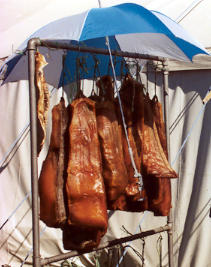 I thought this recipe would be very usefull since I tend to have rotten things in my frigidaire. Imagine, I could make "rotten pork chops" or "rotten chicken" or "rotten left over thanksgiving dinner". The recipes are from a great website reachable with a click on Jo's Icelandic Recipes.
I thought this recipe would be very usefull since I tend to have rotten things in my frigidaire. Imagine, I could make "rotten pork chops" or "rotten chicken" or "rotten left over thanksgiving dinner". The recipes are from a great website reachable with a click on Jo's Icelandic Recipes.**Don't try this at home unless you know what the end product is supposed to taste like. Putrefied shark can become spoiled (imagine that!)
Traditional method:
Take one large shark, gut and discard the innards, the cartilage and the head. Cut flesh into large pieces.Wash in running water to get all slime and blood off. Dig a large hole in coarse gravel, preferably down by the sea and far from the nearest inhabited house - this is to make sure the smell doesn't bother anybody. Put in the shark pieces, and press them well together.
 It's best to do this when the weather is fairly warm (but not hot), as it hastens the curing process. Cover with more gravel and put heavy rocks on top to press down. Leave for 6-7 weeks (in summer) to 2-3 months (in winter). During this time, fluid will drain from the shark flesh, and putrefaction will set in.
It's best to do this when the weather is fairly warm (but not hot), as it hastens the curing process. Cover with more gravel and put heavy rocks on top to press down. Leave for 6-7 weeks (in summer) to 2-3 months (in winter). During this time, fluid will drain from the shark flesh, and putrefaction will set in.When the shark is soft and smells like ammonia, remove from the gravel, wash, and hang in a drying shack. This is a shack or shed with plenty of holes to let the wind in, but enough shade to prevent the sun from shining directly on the shark. Let it hang until it is firm and fairly dry: 2-4 months. Warm, windy and dry weather will hasten the process, while cold, damp and still weather will delay it. Slice off the brown crust, cut the whitish flesh into small pieces and serve, preferably with a shot of ice-cold brennivín.
Modern Method:
The modern method for curing shark relies on putting it into a large container with a drainage hole, and letting it cure as it does when buried in gravel.
